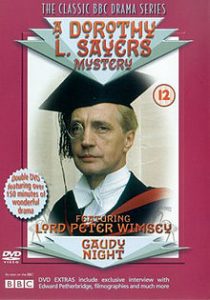 You can’t sell Lord Peter Wimsey to a classroom full of millennials. I’m sorry. You. Just. Cannot. Even A.C. Doyle’s “Silver Blaze,” with which I begin my survey course on mystery fiction, is met with cries of “What’s in it for me?” and “It’s just not relatable” (the latter a neologism I cordially despise). Or as Edmund Wilson would have it, “Who Cares who Killed Roger Ackroyd?”
You can’t sell Lord Peter Wimsey to a classroom full of millennials. I’m sorry. You. Just. Cannot. Even A.C. Doyle’s “Silver Blaze,” with which I begin my survey course on mystery fiction, is met with cries of “What’s in it for me?” and “It’s just not relatable” (the latter a neologism I cordially despise). Or as Edmund Wilson would have it, “Who Cares who Killed Roger Ackroyd?”
Teaching the Golden Age mystery – on which I cut my escapist teeth – is hard, for, as W.H. Auden demonstrated in “The Guilty Vicarage,” it is a socially, morally, and epistemologically normative genre policed by a detective who is an intellectual and social snob. (And Auden was a fan.) And when you think of it in those terms, why should students care? By the time I finally gave up and cut poor Dorothy Sayers from the syllabus, I found myself asking myself why I loved Gaudy Night so much after all.
So is the detective story nothing but a hopelessly nostalgic fantasy of a time and place of an epistemological and social certainty that never was? Well, yes. They wouldn’t call it a Golden Age if it were real, now would they? The entire point of an idyl, whether it sings of Theocritus’ nymphs and satyrs or Tennyson’s King Arthur, is to celebrate a lost state of perfection that never really existed. (Okay, I had to sneak that it. It’s the first time in my life that I’ve ever been able to introduce one of my abstruse orals topics into polite conversation.) Still, it is no coincidence the Golden Age mystery flourished between the two World Wars – a time of considerable, social, moral, and epistemological upheaval. For the idyl is a profoundly conservative form, which offers the fantasy of a return to a vanished Eden from which we have fallen.
And yes, in the wrong hands, this quest to recover a lost state of grace rapidly turns into a quest to scapegoat the Other. Doyle’s assumptions about class and race pop out like a missing stud on a starched shirt front; The Sign of Four is one of the very few texts I consider too racist to teach. However, the very fact that the Golden Age never existed in reality paradoxically opens up tremendous post-modernist literary possibilities for those who write from outside the closed society whose values the Golden Age detective story reinforces.
“Silver Blaze” met with grudging acceptance at best. But Sherlock’s “Empty Hearse” met with no such objections. Many would say (myself included) that Sherlock wound up hoist on the petard of its own cleverness. But “The Empty Hearse” is an elegant homage to fans and fan fiction. (For more on that see Emily Nussbaum’s article in The New Yorker.) The episode is also a slick post-modernist take on Lacan’s and Derrida’s seminal readings of “The Purloined Letter,” in which they demonstrate the inherent instability of the mystery’s central promise epistemological certainty – for (apologies for the ugly flashback to Lit Crit 101), any truth is inherently conditioned by the symbolic order of the subject that construes that meaning. (Okay, that was pretty painless, wasn’t it?)
Thus, according to Derrida (and Quentin Tarantino after him), the purpose of any search for the solution to a puzzle can only be to spin further narratives. Dare I introduce the term “absent referent” here? Or, as Hitchcock put it much more simply and elegantly, the MacGuffin. Manuel Ramos’ “The Skull of Pancho Villa” begins with a wonderful counter-narrative to the tale of how the titular MacGuffin was stolen by a mercenary in 1926 and wound up in the possession of Prescott Bush, “grandfather of you-know-who,” and now rests in Skull and Bones at Yale. Instead, Gus Corral, the narrator claims his Grandpa Alberto, the Chicano flunky who actually dug up the grave, kept it, and it remains in the possession of the Corral family, “stored in various containers like hat boxes, cardboard chests, and even a see-through case designed for a basketball.” The conflicting narratives are in themselves a wonderful commentary on the United States’ relationship with its Latin American neighbors, but the true joy of the story is that those narratives are as much of a MacGuffin as the skull, which has little role in the mystery itself beyond making a memorable return with a “lime-green sombrero with red dingle balls balanced on his slick, shiny head.”
Desideria Belen Ayute, the narrator of Carlos Hernandez’ “Los Simpaticos,” solves a classic Golden Age locked room puzzle halfway through the story, whereupon she breaks the fourth wall to deliver a lecture on why Latinos prefer judgement to puzzles – and why this makes the telenovela their art form of choice. She then goes on to deliver the criminal into the hands of the U.S. courts, not out of any abstract belief in justice, but rather because it makes a simpler and tidier instrument of revenge than picking up a weapon herself.
Then there’s Mark Haddon’s The Curious Incident of the Dog in the Night. I wrote in a previous post about how difficult I found it to write in the first person from any point of view other than my own. Haddon uses the equivalence of the reader and the detective, first pointed out by Tsvetan Todorov, to manage this feat. Christopher’s mindset may be very different from his reader’s, but they are connected by being in the same position as they both struggle to “read” the text of the central mystery. Even more importantly, the very nature of autism means that Christopher’s quest is a fictional demonstration of Lacan’s claims, for Christopher’s cognitive difficulties all stem from the fact that he has no symbolic order to condition his ordering of facts into a narrative that can create meaning.
Perhaps most fascinating of all of these counter-narratives is Randolph Fisher’s extraordinary The Conjure-Man Dies, written during Harlem’s own Golden Age, decades before post-modernism was a gleam in Derrida’s eye. But more on that next time.
 —Erica Obey
—Erica Obey
Erica Obey is the author of, most recently, The Lazarus Vector and The Curse of the Braddock Brides.
